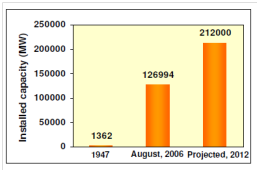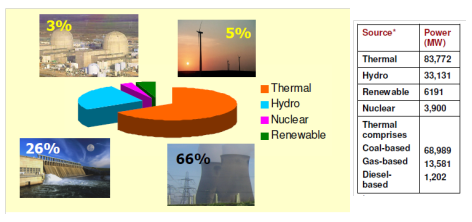Power Generation
Do you know what the total electricity generation through power utilities was in 1947? It was a meagre1362 MW. It has increased 100 times in about 60 years (figure). Another 14636 MW of captive producing capacity is also connected to the grid

Figure: Total Electricity Generation: Actual and Projected
Though there is a importance increase in power generation capacity within the last 60 years, we still have a long way to go. You know in which country is still plagued by severe power shortages. As per official statistics, the total energy shortage during the year 2005-2006 stood at 8.3% and the peak shortage was 12.3 percent during the similar period.
Inadequate generation capacity is one of the purposes for power shortage. Based on the 16th EPS projections, over 1,00,000 MW generation capacity is needed to be added during the Xth and XIth plan period, i.e., by 2012 to bridge the gap among supply and demand of power. Let us look at the power generation sector extremely briefly to understand the options available to us.
Electric power generation globally relies on four basic energy sources: Fossil fuels such as coal, oil and natural gas; Nuclear power; Hydroelectricity; and Renewable energy sources such as solar, bio-fuels, biomass, tidal and wind. As of September, 2006, about 66 % of the power generated globally is from coal based thermal power plants. The hydro-electric power plants account for about 26% of total electricity generation, nuclear power plants for about 3% and the remaining 5% comes from renewable energy resources.

Figure: Electric Power Generation Source-Mix globally